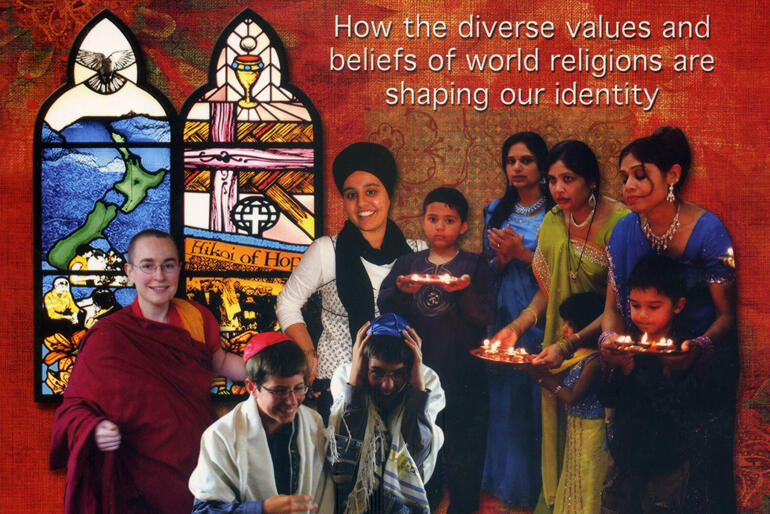
When Aotearoa New Zealand’s Religious Diversity Centre hosted Jewish and Muslim students to a dialogue last year they shared stories of hostile words and acts of abuse each had experienced in schools and public places around this country.
Students from both faith communities agreed that ‘keeping your head down’ is a useful response for a young person from a minority faith in New Zealand.
After Friday 15 March this year, those heads already bowed by harassment, were weighed down in grief and fear when the news of multiple murders at two Christchurch mosques came through.
And yet, amid the nation’s outpouring of shock, sympathy and support, any who visited the mosques these past weeks were greeted warmly by Muslim women and men, young people and old, all with their heads held high. These were not people with angry, vengeful heads, but courageous heads, heads full of wonder at the aroha streaming over them, grateful beyond words, for the words of peace: ‘Salaam alaikum’, ‘Peace be upon you’.
The world was watching these weeks unfold as a murderous act of hate was met by an outpouring of by compassion and grace. From his wheelchair, Farid Ahmed, his wife a victim of the massacre, pronounced forgiveness towards the gunman. It is hard to imagine that such a miracle as that could fade. But time and normality can dull the memory as those of us not directly affected move on and ‘get on with our lives’.
These past weeks, however, have shown us a New Zealand that refuses to accept that people must live in a place where to survive they have to keep their heads down. We have glimpsed a new community of distinctive difference bound together in mutual appreciation. So what can keep all of our heads held high, with faces and hearts turned toward one another?
Two years ago a gathering of the nation’s religious leaders began to meet through the Religious Diversity Centre. 23 leaders from Baha’i, Buddhist, Christian, Hindu, Jewish, Muslim, and Sikh faiths came together to discuss shared concerns.
A main focus has been to recognise the harassment, and accompanying fear of injury and harm that has been a common experience of members of this country’s minority religious communities.
Leaders at the meetings agreed that a key place to address these problems is in schools, where they believe all New Zealand students should have the opportunity to learn about different religions, taught by trained teachers with a well-prepared curriculum and resources.
In Aotearoa New Zealand’s secular school curriculum there is already provision for teachers to include religion in subjects such as Philosophy, History and Social Studies and to assess students using the Religious Studies NCEA Achievement Standards.
Importantly, this space for teaching about religious traditions takes an academic approach that stands apart from proselytising, so it does not provide a space where teachers are encouraging students to adopt one or another creed.
In religious and church schools, and in Catholic schools in particular, there has been significant development toward building broader religious understanding through the curriculum.
Over the past twenty years Auckland’s Diocesan School for Girls has developed a strong multi-strand curriculum including Christianity, World Religions and Ethics strands.
“The students develop the capacity to see behind fear-stirring media or extremism posing as free speech or mainstream normalcy”, says Auckland Dio’s Chaplain, the Reverend Sandy Robertson.
“The religions have so much in common - I didn’t know that before.” shared a 16-year old student who had encountered the world religions at a recent Leadership Diversity Day organised by the Auckland Interfaith Council.
“I learnt how to acknowledge the effect of different religious backgrounds rather than assuming everyone is like me,” he said.
Anglican Schools Office Director, the Rev Dr Ann van Gend confirmed that Anglican and special character schools with a Christian RE curriculum often teach a world religions strand.
Many Aotearoa New Zealand RE teachers use world religion resources from the UK’s RE Today.
“These resources are multi-religious, and there are hundreds of them, all of excellent quality.” said Ann.
“Each teacher here can create their own units of work using resources such as those, and they contextualise them for their own schools.”
New Zealand’s Interfaith network also lists UK-based REonline as a good source of educational resources.
Ultimately studying religious beliefs different to one’s own helps students to recognise and respect others’ diverse religious commitments, rather than relying on media reports or hearsay to form ill-informed opinions of others’ beliefs. Within the school community this can mean less bullying and less alienation between students of different backgrounds.
Over the long-term, more students studying world religions could lead to a better understanding of religion’s role in other people’s lives. This in turn could help us become a better informed, more open-hearted New Zealand, retaining that precious spirit of aroha we shared in the days and weeks after 15 March 2019.
Jocelyn Armstrong is Chair of The Religious Diversity Centre Trust, a former school chaplain including at Auckland Diocesan School for Girls and RE teacher and author.
After many years’ experience teaching world religious in classrooms, Jocelyn Armstrong produced her own Level Five Social Studies Textbook for use in Aotearoa New Zealand, ‘Discovering Diversity, How the diverse values and beliefs of world religions are shaping our identity’ which has been published by Pearson.

















Comments
Log in or create a user account to comment.